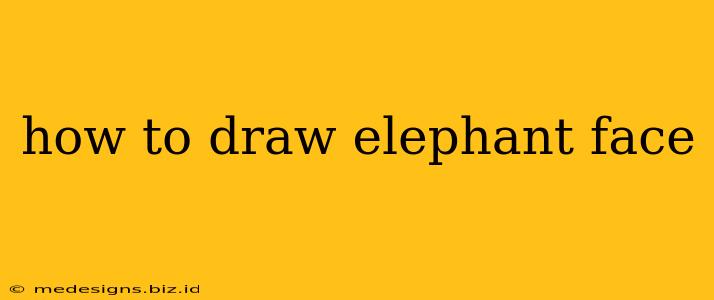Drawing an elephant face might seem daunting, but with a little patience and these simple steps, you'll be creating adorable or realistic elephant portraits in no time! This guide caters to both beginners and those looking to refine their elephant-drawing skills. We'll cover different styles, ensuring you find a method that suits your artistic preferences.
Getting Started: Materials You'll Need
Before we begin our artistic journey, gather your essential art supplies. You'll need:
- Paper: Choose a paper weight that suits your drawing style. Thicker paper is ideal for charcoal or watercolor, while lighter paper works well with pencils.
- Pencils: A variety of pencils (H for light sketching, HB for general use, and B for darker shading) will give you greater control over your lines and shading.
- Eraser: A kneaded eraser is highly recommended as it allows for precise erasing without damaging the paper.
- Optional: Colored pencils, crayons, markers, or paints for adding color and texture to your finished drawing.
Step-by-Step Guide: Drawing a Cartoon Elephant Face
This method focuses on a simpler, cartoonish elephant face, perfect for beginners or quick sketches.
Step 1: The Basic Shape
Start by drawing a large circle. This will form the base of your elephant's head.
Step 2: The Ears
Draw two large, slightly curved ovals on either side of the circle. These are your elephant's ears. Remember, elephant ears are substantial!
Step 3: The Trunk
From the bottom of the circle, draw a slightly curved line downwards, tapering to a point. This is the elephant's trunk. Add a small circle at the end to represent the nostrils.
Step 4: The Eyes
Add two small circles within the large circle, near the top. These are the eyes. You can add smaller circles within these for pupils.
Step 5: The Tusks (Optional)
If you want to add tusks, draw two slightly curved lines extending downwards from the sides of the trunk.
Step 6: Finishing Touches
Add some wrinkles and lines around the eyes and forehead to give your elephant face more character. You can also add shading to create depth and dimension.
Step-by-Step Guide: Drawing a More Realistic Elephant Face
This method involves more detail and will result in a more lifelike elephant portrait.
Step 1: The Head Shape
Begin with a slightly elongated oval shape, slightly wider at the top and narrower at the bottom. This forms the basic head shape.
Step 2: The Ears
Draw large, irregular-shaped ovals for the ears. Unlike the cartoon version, these should have more detailed curves and folds.
Step 3: The Trunk
Draw a more complex trunk, starting from the bottom of the oval. Consider the folds and wrinkles that make the trunk look realistic.
Step 4: The Eyes and Forehead
Draw the eyes smaller and more deeply set than in the cartoon version. Add wrinkles and lines to the forehead to mimic the elephant's skin texture.
Step 5: Tusks and Mouth
Draw the tusks, paying attention to the curve and shape. Lightly sketch the mouth area and add details to the trunk's end.
Step 6: Shading and Detailing
Use shading techniques (hatching, cross-hatching, blending) to create depth and texture. Focus on the folds in the skin, particularly around the eyes, ears, and trunk. Consider adding highlights to make the elephant's face come alive!
Tips for Success
- Practice makes perfect: Don't be discouraged if your first attempts aren't perfect. Keep practicing, and you'll improve.
- Reference images: Use photographs or videos of elephants as references to help you get the proportions and details right.
- Light and shadow: Pay attention to how light and shadow affect the elephant's face. This will help you create a more realistic drawing.
- Have fun! Drawing should be enjoyable. Experiment with different styles and techniques.
By following these steps and practicing regularly, you'll master the art of drawing elephant faces. Remember to experiment, have fun, and let your creativity shine!
